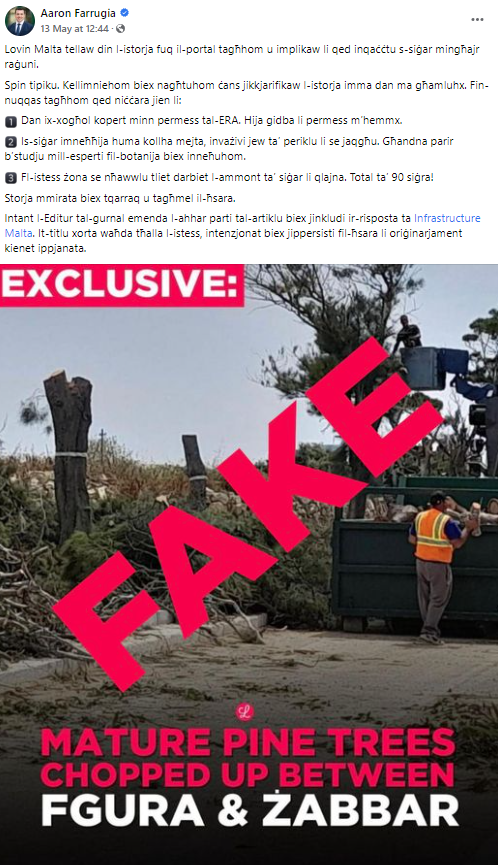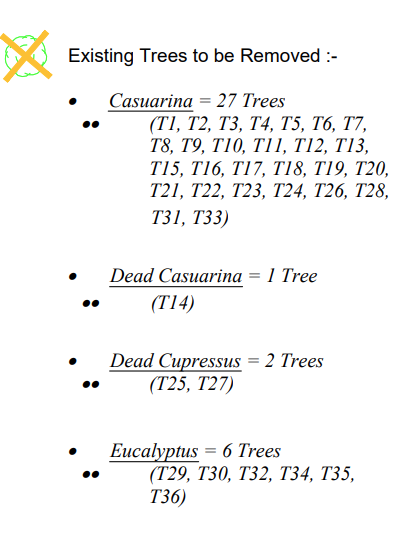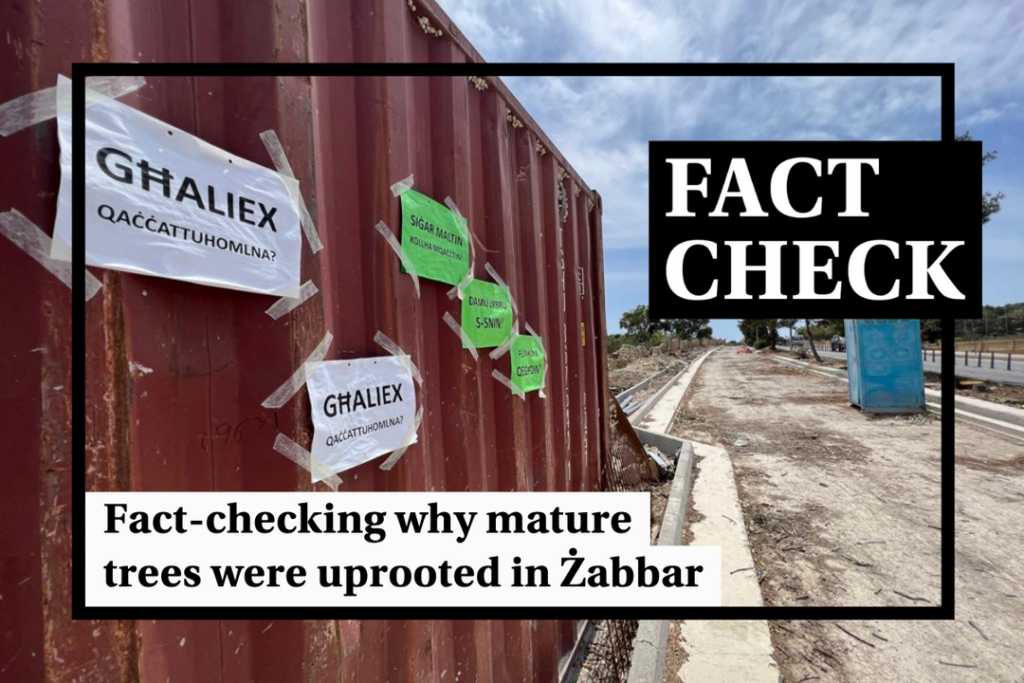Residents were outraged by reports late last week of several mature trees being cut down as roadworks took place in Triq il-Kunsill tal-Ewropa, a road connecting the towns of Żabbar and Fgura.
Several residents took to social media to express their dismay, asking why the trees were being removed, whether there was a permit for their removal and what justification there was for much-needed mature trees to be cut down.
This came in the wake of several controversial instances of tree removal over the past years, often with little or no explanation or as part of roadworks taking place around the island.

Reacting to media reports about the removal of the trees, Transport and Infrastructure Minister Aaron Farrugia argued that the trees removed were either dead, sick or invasive and that permits were in place for their removal.

Times of Malta received several requests from readers to fact-check various issues raised, including the types of trees removed, whether works were covered by permits and whether the trees were really dead or sick, as claimed.
What works are taking place?
Roadworks are being carried out in the area by Infrastructure Malta, with Triq il-Kunsill tal-Ewropa (also known as Vjal Kottoner) being redesigned and repaved.
Plans submitted show that the road is set to have a single lane of traffic in each direction, together with an almost five-metre-wide segregated bicycle and pedestrian path running along one side of the road. The road will have vehicle parking and a footpath on the opposite side.
An Infrastructure Malta spokesperson compared the project to the works done in Triq Bormla (known as Taċ-Ċawsli) in the town of Żejtun, which received a similar redesign in 2019.
How many trees were removed?
Plans for the project show that a total of 36 trees were cut down, most of them lining a single side of the road. Of these, 28 were casuarina trees, two were cypress trees and a further six were eucalyptus trees.

Were the trees invasive?
Most of the trees removed were invasive, although some others are protected species.
Casuarina trees, commonly known as Australian Pine or She-Oak, are classified as an invasive species and are described in Maltese law as “deemed to be detrimental to the natural environment”. It is illegal to plant, sell or propagate casuarina trees, and the law allows authorities to order the removal of these trees without requiring a permit.
An arborist who spoke to Times of Malta explained that casuarina trees were widely planted in past decades as they are fast growers and require relatively little care, with these trees becoming a common sight across Maltese urban landscapes.
Cypress and eucalyptus trees, on the other hand, are not considered invasive. While eucalyptus trees are not protected, Malta’s Trees and Woodlands Protection Regulations list cypress trees as a tree that is protected within several areas, including ODZ, in green enclaves within urban areas and in urban public open spaces.
Were the trees dead?
Although some of the trees removed were dead, the vast majority were not.
Of the 28 casuarina trees removed, only one of them was dead. Both cypress trees removed were dead, while all six eucalyptus trees are listed as being alive.
However, a report by horticultural expert Peter Calleja describes several of the trees as “in a very bad state”, describing the eucalyptus trees as either dead, infested by wood boring insects or posing a danger by leaning on to the carriageway.
The report does not state how many of the trees were sick.

Was there a permit for their removal?
Infrastructure Malta was granted a permit by the Environment & Resource Authority on May 9. Works began a few days later.
The permit only covers the removal of the cypress and eucalyptus trees. The law stipulates that casuarina trees can be removed without a permit.

Will the trees be replaced?
Documents seen by Times of Malta show that Infrastrucure Malta is seeking to purchase up to 145 cypress and oak (commonly known as balluta) trees between two and three metres in height, together with several myrtle shrubs to plant along the street.
An Infrastructure Malta spokesperson told Times of Malta that although there is only space for just under 100 trees along the road, they will be seeking to plant the remaining trees in the vicinity. The trees are expected to be planted towards the end of the year.
Did the trees really need to be removed?
Opinions on the matter are divided.
Speaking to Times of Malta, former MEPA assistant director Alfred Baldacchino said that “just because a tree is invasive it doesn’t mean that it should be removed”, arguing that the management of trees needs to be accompanied by a holistic plan including the development of a nursery for indigenous trees.
Baldacchino admitted that invasive trees such as the casuarina may need to be replaced but questioned whether authorities are consulting the right type of experts when carrying out works.
An arborist who spoke to Times of Malta explained that several mature trees planted in urban areas across Malta are not suitable for their particular context, either because they are an invasive species or because of their particular characteristics (such as having wide branch canopies in areas where more narrow canopies would be more appropriate).
The arborist said that while it is never desirable to see a mature tree uprooted, there are circumstances in which replacing invasive or inappropriately-placed trees is a suitable course of action, as long as there is a well-developed plan for their replacement.
“We need to follow the principle of planting the right tree in the right place and not repeat our past mistakes,” the arborist said, adding that aside from indigenous trees such as oak and cypress, there are several non-invasive, non-indigenous trees that would be more suitable for such a spot.
In comments to Times of Malta, Astrid Vella, coordinator of environmental NGO Flimkien għal Ambjent Aħjar, argued that “the argument of the casuarina trees being invasive is relative. While such a tree would be invasive in a purely natural setting, it poses a much lesser threat when planted by a tarmacked roadside”.
Vella described the public outcry over the trees’ destruction as “understandable”, adding that “we have to plan roads to accommodate mature trees, as is done abroad, and not destroy them”.
She argued that Fgura has one of the highest rates of air pollution, with residents negatively impacted by a similar incident in which trees lining Żabbar road were uprooted.
The Times of Malta fact-checking service forms part of the Mediterranean Digital Media Observatory (MedDMO) and the European Digital Media Observatory (EDMO), an independent observatory with hubs across all 27 EU member states that is funded by the EU’s Digital Europe programme. Fact-checks are based on our code of principles.
Let us know what you would like us to fact-check, understand our ratings system or see our answers to Frequently Asked Questions about the service.





